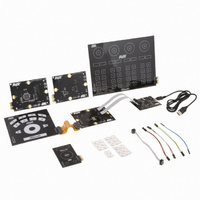ATQT600 Atmel, ATQT600 Datasheet - Page 13

ATQT600
Manufacturer Part Number
ATQT600
Description
KIT EVAL TOUCH FOR QT600
Manufacturer
Atmel
Series
QTouch™r
Specifications of ATQT600
Sensor Type
Touch Screen
Interface
USB
Embedded
Yes, Other
Utilized Ic / Part
ATtiny88, ATmega324PA, ATxmega128A1
Processor To Be Evaluated
ATtiny88, ATmega324, ATxmega128
Data Bus Width
8 bit, 16 bit
Interface Type
USB
Maximum Operating Temperature
+ 85 C
Minimum Operating Temperature
- 40 C
Operating Supply Voltage
1.6 V to 3.6 V
Silicon Manufacturer
Atmel
Kit Application Type
Sensor
Application Sub Type
Touch Sensor
Kit Contents
USB Bridge, MCU Cards, Touchpad Cards
Svhc
No SVHC (15-Dec-2010)
Mcu Supported Families
ATtiny88,
Rohs Compliant
Yes
Lead Free Status / RoHS Status
Lead free / RoHS Compliant
Voltage - Supply
-
Sensitivity
-
Sensing Range
-
Lead Free Status / Rohs Status
Lead free / RoHS Compliant
Available stocks
Company
Part Number
Manufacturer
Quantity
Price
Company:
Part Number:
ATQT600
Manufacturer:
Atmel
Quantity:
135
2.2
2.2.1
2.2.2
2.2.3
2.2.4
Touch Sensors Design Guide
Components
Cs Capacitor
Series Resistors
Voltage Regulator
Component Placement
Charge transfer uses an integration capacitor (Cs) to measure changes in Cx. The Cs capacitor
accumulates charge over a number of charge transfer pulses. Ultimately, the voltage on Cs is used as
the basis of the measurement. Clearly then, the stability of Cs is important to obtain a consistent and
repeatable measurement. In general, you can easily achieve this by making sure that Cs is an X7R or
X5R type of capacitor. If possible, use a COG type, as these have the highest stability. In practice,
though, this limits Cs to around 1 nF, and often Cs needs to be higher – sometimes as much as 100 nF.
In this case, use an X7R or X5R type capacitor.
All Atmel capacitive sense chips use drift compensation methods to correct for slow-rate thermal
changes in Cs. Faster rate changes are not possible to compensate for in this way, and for this reason
you should never try to use Y5R type capacitors; they are simply too unstable.
A short-term change in Cs that can sometimes be observed on sensors using elevated gain is an effect
known as dielectric absorption. This is a complex physical mechanism whereby charge becomes
"trapped" in discontinuities in the dielectric lattice of the capacitor. This manifests itself as changes in the
value of Cs that are a function of the previous voltage history on the capacitor. Dielectric absorption is
rarely observed in practice, but every now and then it can disrupt a project, causing shifts in the
background reading as the senor chip exits from sleep mode
sleep modes; it is never seen in a continuous run mode. If this kind of effect is suspected, try changing to
another brand of capacitor for Cs. Some modern Hi-K ultra-small X5R capacitors (for example, 0201
size) have been shown to demonstrate such behavior. However, it has not been seen by Atmel as a
significant effect for 0402, 0603, 0805 sized components.
The series resistors are non critical and have no special characteristics. 10 percent, or better, tolerance
is fine, and generally 200 ppm/°C is more than stable enough.
Use a good quality linear regulated supply for Vdd to the sensor chip. Remember that long term shifts in
Vdd are compensated for by the internal drift algorithms, but short-term shifts or spikes on Vdd can be
problematic. Refer to the sensor chip's datasheet for advice on regulator types.
All passive components associated with the capacitive sensor (such as the Cs reference capacitors and
associated resistors) should be placed as close to the control chip as is physically possible to assist with
EMC compliance. Avoid compromises in layout in this regard; placing such components closer to the
chip is always better.
If these parts are placed far from the chip, serious noise problems and instabilities can arise. A common
mistake is to place the series resistors at the actual key locations instead of at the chip. The trace length
from the chip to the passive components is just as important as the distance from the chip to the actual
key.
1. That is, some period of no charge-discharge activity on Cs, which causes it to change value slightly.
(1)
. Note that this effect can appear only in
General Advice
10620D–AT42–04/09
2-3













